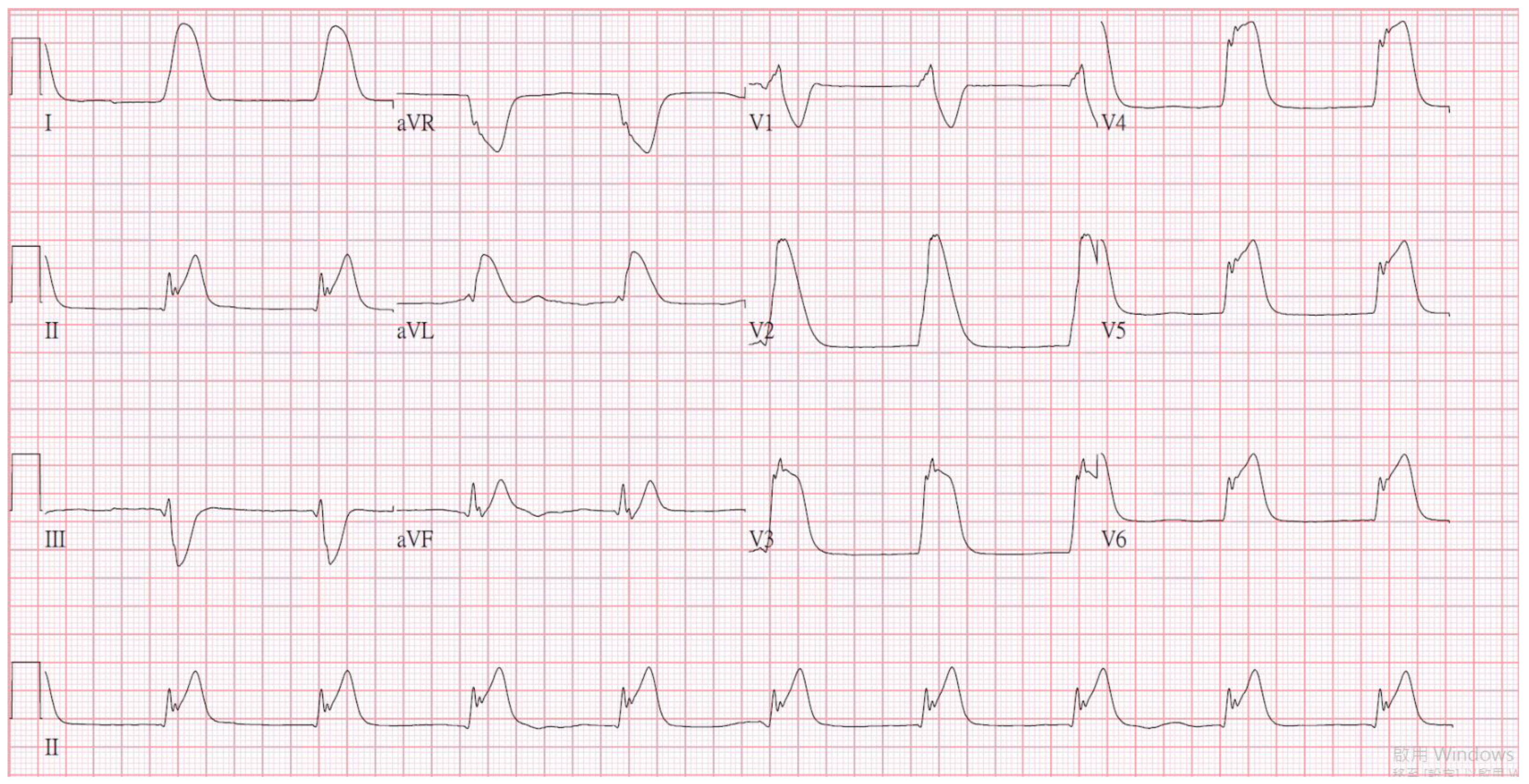The Spiked Helmet Sign Predicting a Poor Outcome in a Patient with Non-Myocardial Infarction ST-Segment Elevation
Abstract
:1. Introduction
2. Case Presentation
3. Discussion
4. Conclusions
Author Contributions
Funding
Institutional Review Board Statement
Informed Consent Statement
Data Availability Statement
Conflicts of Interest
References
- Littmann, L.; Monroe, M.H. The “Spiked Helmet” Sign: A New Electrocardiographic Marker of Critical Illness and High Risk of Death. Mayo Clin. Proc. 2011, 86, 1245–1246. [Google Scholar] [CrossRef] [PubMed] [Green Version]
- Vleugels, A.; Vereecke, J.; Carmeliet, E. Ionic Currents During Hypoxia in Voltage-Clamped Cat Ventricular Muscle. Circ. Res. 1980, 47, 501–508. [Google Scholar] [CrossRef] [Green Version]
- Di Diego, J.M.; Antzelevitch, C. Acute Myocardial Ischemia: Cellular Mechanisms Underlying St Segment Elevation. J. Electrocardiol. 2014, 47, 486–490. [Google Scholar] [CrossRef] [Green Version]
- Montecucco, F.; Carbone, F.; Schindler, T.H. Pathophysiology of St-Segment Elevation Myocardial Infarction: Novel Mechanisms and Treatments. Eur. Heart J. 2015, 37, 1268–1283. [Google Scholar] [CrossRef] [Green Version]
- Carmeliet, E. Cardiac Ionic Currents and Acute Ischemia: From Channels to Arrhythmias. Physiol. Rev. 1999, 79, 917–1017. [Google Scholar] [CrossRef] [PubMed]
- Simon, A.; Járai, Z. Is the Spiked Helmet Sign the Manifestation of Long Qt Syndrome? J. Electrocardiol. 2019, 55, 16–19. [Google Scholar] [CrossRef] [PubMed]
- Tomcsányi, J.; Frész, T.; Bózsik, B. St Elevation Anterior “Spiked Helmet” Sign. Mayo Clin. Proc. 2012, 87, 309. [Google Scholar] [CrossRef] [Green Version]
- Aliyev, F.; Abdulkerimov, V.; Gul, E.E.; Samedov, F.; Isayev, E.; Ferecov, E. Spiked Helmet Sign after Percutaneous Left Stellate Ganglion Ablation in a Patient with Long Qt Syndrome. J. Electrocardiol. 2017, 50, 944–946. [Google Scholar] [CrossRef]
- Samadov, F.; Gasimov, E.; Aliyev, F.; Isayev, E. The “Spiked Helmet” Sign—A Potential Relationship to Takotsubo Cardiomyopathy. Am. J. Emerg. Med. 2018, 36, 345.e5–345.e7. [Google Scholar] [CrossRef] [PubMed]
- Agarwal, A.; Janz, T.G.; Garikipati, N.V. Spiked Helmet Sign: An under-Recognized Electrocardiogram Finding in Critically Ill Patients. Indian J. Crit. Care Med. 2014, 18, 238–240. [Google Scholar] [CrossRef] [PubMed] [Green Version]
- Oluyadi, F.; Kariyanna, P.T.; Jayarangaiah, A.; Celenza-Salvatore, J.; McFarlane, I.M. Helmet Sign on Ekg: A Rare Indicator of Poor Prognosis in Critically Ill Patients. Am. J. Med. Case Rep. 2019, 7, 260–263. [Google Scholar] [CrossRef] [PubMed]
- Laundon, R.K.; Littmann, L. Spiked Helmet Pattern St Elevation in Subarachnoid Hemorrhage. J. Electrocardiol. 2019, 52, 96–98. [Google Scholar] [CrossRef] [PubMed]



Publisher’s Note: MDPI stays neutral with regard to jurisdictional claims in published maps and institutional affiliations. |
© 2021 by the authors. Licensee MDPI, Basel, Switzerland. This article is an open access article distributed under the terms and conditions of the Creative Commons Attribution (CC BY) license (https://creativecommons.org/licenses/by/4.0/).
Share and Cite
Shih, S.-Y.; Hou, Y.-T.; Lin, P.-C.; Chen, Y.-L.; Chien, D.-S.; Yiang, G.-T.; Wu, M.-Y. The Spiked Helmet Sign Predicting a Poor Outcome in a Patient with Non-Myocardial Infarction ST-Segment Elevation. Medicina 2021, 57, 1184. https://doi.org/10.3390/medicina57111184
Shih S-Y, Hou Y-T, Lin P-C, Chen Y-L, Chien D-S, Yiang G-T, Wu M-Y. The Spiked Helmet Sign Predicting a Poor Outcome in a Patient with Non-Myocardial Infarction ST-Segment Elevation. Medicina. 2021; 57(11):1184. https://doi.org/10.3390/medicina57111184
Chicago/Turabian StyleShih, Shu-Yu, Yueh-Tseng Hou, Po-Chen Lin, Yu-Long Chen, Da-Sen Chien, Giou-Teng Yiang, and Meng-Yu Wu. 2021. "The Spiked Helmet Sign Predicting a Poor Outcome in a Patient with Non-Myocardial Infarction ST-Segment Elevation" Medicina 57, no. 11: 1184. https://doi.org/10.3390/medicina57111184
APA StyleShih, S. -Y., Hou, Y. -T., Lin, P. -C., Chen, Y. -L., Chien, D. -S., Yiang, G. -T., & Wu, M. -Y. (2021). The Spiked Helmet Sign Predicting a Poor Outcome in a Patient with Non-Myocardial Infarction ST-Segment Elevation. Medicina, 57(11), 1184. https://doi.org/10.3390/medicina57111184






